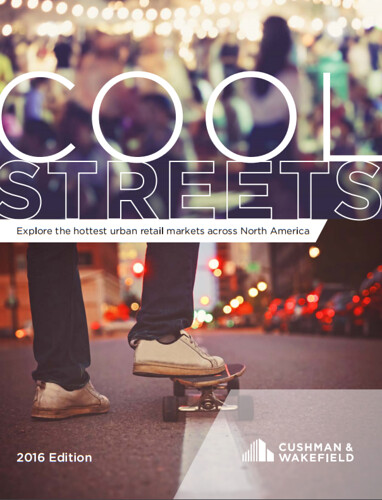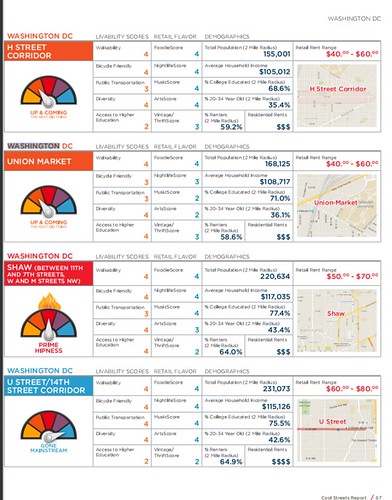Cushman & Wakefield report on top "Cool Streets" retail/mixed use districts across the US
 Cushman & Wakefield is a multifaceted commercial real estate firm, with a national and globally significant presence in the brokerage side.
Cushman & Wakefield is a multifaceted commercial real estate firm, with a national and globally significant presence in the brokerage side. Their Cool Streets Report, released in May, is a "hot list" of the retail-mixed use districts in the US and Canada's major cities that are attractive to regional and national retailers and property developers.
The 2016 report lists these as the top 15:
- Brooklyn / Sunset Park
- Chicago / Logan Square
- Cincinnati / Over-the-Rhine
- Denver / RiNo
- Los Angeles / Silver Lake
- Miami / Wynwood
- Minneapolis / North Loop
- Phoenix / Roosevelt Row
- Richmond / Carytown
- San Diego / East Village
- San Francisco / Jackson Square
- St. Louis / Delmar Loop
- Toronto / West Queen West
- Vancouver / Mount Pleasant / Main Street
- Washington D.C. / Shaw

From the standpoint of commercial district revitalization planning, these are the places professionals learn and see presentations about at national conferences, that get media attention, and are the ones that we try to visit when we travel.
Supermarket News reports how these kinds of districts are the ones attracting innovative supermarket concepts like 365 by Whole Foods in Silver Lake, Los Angeles, or the bfresh markets by Ahold in Boston.
The funny thing is that it has taken these districts a very long time to move up the ladder and onto the radar of commercial real estate brokers and "credit tenants"--national retailers.
For example, when I first got into "Main Street" type activities back in 2001, one of my e-colleagues was working on issues in Over the Rhine in Cincinnati.
 Style Weekly image.
Style Weekly image.National interest isn't always seen as desirable. And Carytown, its main "credit tenants" back then were a Kroger and a McDonalds.
The rest were and the vast majority still are local independents, although a Whole Foods opened up a few years ago, with a lot of controversy as it competes with the local Ellwood Thompson natural foods supermarket ("Boxing Carytown: From Wal-Mart to Whole Foods," Style Weekly; "Carytown business community thinks outside the box," Richmond BizSense).
This Style Weekly piece, "When Chains Break: Once Pandora's big box opens in Carytown, there may be no closing it," captures the angst around becoming a "nationally significant" retail district and how this changes the retail mix, brings in more national companies, leads to rises in rents, etc., but also brings in more customers.
Also see the past blog entries, "Retail and authenticity: continued" and ""high street" retail real estate."
Still, the demand for "Cool Streets" is surprising. Or because of the National Main Streets conference in Chicago in 2008, I was able to meet Aaron Renn, who writes/produces the Urbanophile (he's done a way better job of monetizing urban blogging than I ever have) and Lynn Stevens of Peopling Places, in a meeting she set up to show me her Logan Square neighborhood, which then was just starting to move "up" but had plenty of vacant properties, disinvested properties, and tough spatial and urban design conditions, but great building stock generally, access to regional parks, and a subway stop.
With DC's Shaw District, I was thinking about writing about it because in the Spring Restaurant issue of the Washington Post Magazine, it was picked as the city's hottest district for great and interesting and new restaurants. And the new Glen's Garden Market is featured in Design and Display Ideas, a trade magazine on retail visual merchandising.
What a triumph this is for the Shaw Main Streets program, which has been diligently working on reviving that area's retail offer since 2002 (they tried for designation in 2002, but didn't receive it until the 2003 round).
Also see "It ain't true: chain retailers are entering the city, but not necessarily on the city's terms" and
"Another point about urban retail: Whole Foods, Design within Reach, and American Apparel."
====
Note that for decades, Cushman and Wakefield has been producing a similar report at the global scale. MAIN STREETS ACROSS THE WORLD 2015/2016 tracks the world's top 500 "Cool Streets" retail districts. While it does discuss global consumer and other trends that impact consumer behavior, districts are chosen for listing based on rental rates per square foot, not "coolness."
Labels: commercial district revitalization, commercial real estate market, formula retail, independent retailing, urban design/placemaking, urban revitalization



2 Comments:
Need to catch up on Aaron Renn. Used to read him regularly then I strayed for some reason.
He is always insightful. Mostly I agree with him. Not absolutely always. He has a nice and wide ranging perspective that is important to stay abreast of.
He has a great piece in the Guardian that I mean to write about, about Sam Schwartz and all he tried to do in NYC in the 1970s.
I don't absolutely love SS because of how his firm said what his client, Town of Chevy Chase, wanted in terms of the Purple Line, but I had no idea he was 30+ years ahead of the curve, compared to Janette Sadik-Khan, although she was in a much better position for implementation.
Post a Comment
<< Home